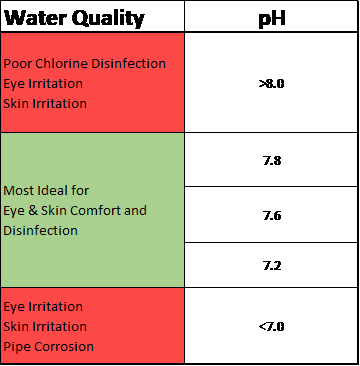
Hot Tubs are relaxing, provide numerous health benefits, and can offer many hours of enjoyment. But, when not properly treated, the warm water in Hot Tubs and the steamy environment around them can be a welcome setting for several common and dangerous bacteria.
The Three Most Common Hot Tub Bacteria are;
- Legionella is a bacterium typically found naturally occurring in water. Hot tubs that are not correctly disinfected can become contaminated with Legionella, which can be the cause of Legionnaires Disease a type of pneumonia or respiratory infection.
- Pseudomonas aeruginosa is a germ often found in water and soil. When present in a hot tub, it can be the cause of a skin rash commonly known as hot tub rash.
- Mycobacterium avium complex (MAC) is a ubiquitous bacterium present in moist environments. Although not as common in hot tubs, it has been cited as responsible for a unique respiratory disease known as hot tub lung.
According to data from the Center for Disease Control and Prevention (CDC), and other medical literature, these three bacteria along with the chemicals used in the treatment of hot tubs, and spas are the primary cause for hot tub-related illness. Following is a short guide outlining the top Hot Tub Bacteria, Illnesses they can cause, symptoms, treatments, and prevention techniques to provide you the information and knowledge needed to ensure your hot tub is a safe environment for your family, and friends. And at the end of the article, we will share some good news!
Hot Tub Bacteria, Illnesses and Symptoms
The Center for Disease Control and Prevention (CDC) publishes a list of the Top 10 causes for all Recreational Water illnesses in a variety of water venues such as pools, spas, hot tubs, and water parks. While the number one cause of all recreational water-related illness is by far the cryptosporidium parasite (nearly 80%), bacteria, primarily Legionella, and Pseudomonas were identified as the primary cause (91.7%) for illnesses that occurred in hot tub/spa only venues. This is likely due to the fact that the cryptosporidium illness is typically transmitted from swallowing and ingesting contaminated water, which is more common in pool and water park settings and is much less common while using a hot tub or spa. A review of the CDC’s detailed data for recreational water illness-related hot tub/spa only venues between 2009 and 2014 shows no cases of Cryptosporidium illness (see table 1).
Table 1
Center for Disease Control and Prevention
2009 thru 2014 Treated Recreation Water Outbreak Data Summary
Hot Tubs/Spas

The most common cause and predominant Illnesses from hot tub/spa related cases reported were;
Legionella is a bacteria that can occur in Hot tubs that are not adequately disinfected, according to the Center for Disease Control and Prevention (CDC). Hot Tubs contaminated with Legionella pose a risk of Legionnaires’ disease, a type of pneumonia or respiratory infection.
According to CDC data, almost 60% of Hot Tub/Spa related illnesses reported between 2009 and 2014, one hundred and fourteen (114) cases, 58.46%, were respiratory infections due to Legionella with more than twenty-five percent (25%) of the reported cases resulting in hospitalization. People become infected when they breathe the Legionella bacteria which is transmitted by aerosolized water droplets in steam or mist from a contaminated hot tub, the CDC says.
Pseudomonas aeruginosa which can cause ear infections, especially in children, and more generalized skin rashes, commonly referred to as “Hot Tub Rash” may occur after exposure to inadequately chlorinated hot tubs or swimming pools. Between 2009 and 2014, sixty-five (65) cases, one-third of the one hundred ninety-five (195) total cases reported, were skin illnesses due to Pseudomonas, none of these illnesses (0%) resulted in hospitalization. Hot Tub Rash or Pseudomonas dermatitis is an infection of the skin, and according to the CDC’s data, is the second most commonly reported illness associated with Hot Tub/Spa usage. The symptoms of Hot Tub Rash include itchy skin with a bumpy red rash or pus-filled blisters usually found surrounding hair follicles. The CDC’s informational resources indicate the disease can be worse or more pronounced in areas under a person’s swimsuit as the suit may keep contaminated water in contact with the skin.
Chemicals/Chlorine were the third primary cause of illness reported in the CDC’s 2009 – 2014 summary data. Chlorine is a chemical used to disinfect recreational water in pools, spas, hot tubs, and water parks. It can significantly irritate the skin, eyes, and respiratory system. Exposure to chlorine can result in raw, swollen skin and cause an itchy red rash.
The rash that develops after coming into contact with chlorine is a condition called irritant contact dermatitis. Not everyone who sits in a chlorinated hot tub will develop a rash. Chlorine rashes are most common after repeated exposure to the chemical or in cases where the free chlorine levels are higher than prescribed.
Symptoms may develop soon after swimming or several days after repeated contact with chlorine. The symptoms of a chlorine rash can vary in intensity from person to person and are similar to symptoms of outbreaks caused by other irritants. They can include dry or chapped skin, burning, stinging, or itching skin, itchy, red, swollen, or scaly patches of skin, and skin sores or blisters that may crack or bleed after repeated contact with chlorine. Along with itchy skin, a person with contact dermatitis may also experience sore eyes or signs of respiratory irritation, such as frequent coughing or sneezing.
If a person with a chlorine rash does not take preventive measures, and they come into frequent contact with the chemical in a short period, their symptoms may worsen.
One additional bacterial contributor to hot tub/spa-related illness worth mentioning is Mycobacterium avium complex (MAC). These ubiquitous bacteria are typically not capable of causing disease without influencing conditions like a suppressed immune system. However, Hot Tub Lung (HTL) is a unique disease sometimes seen in healthy individuals following exposure to hot water in spas with Mycobacterium avium complex (MAC).
Although the CDC’s 2009 thru 2014 data did not indicate any outbreaks for hot tubs/spas caused by Mycobacterium avium complex (MAC), an article published in 2017 by the Ghana Medical Journal, outlined approximately seventy (70) cases of Hot Tub Lung (HTL) described in the English medical literature. The most extensive series of cases reported in this article was from a Mayo Clinic article, which includes a retrospective review of twenty-one (21) patients over seven years.
These bacteria have a unique outer layer that allows them to adhere to surfaces, rather than being washed away by water (as many other bacteria are). If a hot tub is contaminated with MAC, the bacteria can become attached to air bubbles and become aerosolized when the bubbles reach the surface. When people breathe in the bacteria, they may develop “granulomas,” or small areas of inflammation, in their lungs. People with Hot Tub Lung (HTL) may experience flu-like symptoms, including cough, trouble breathing, fever, and fatigue.
Treatments
Legionnaires’ disease is a severe, often lethal, form of pneumonia. As outlined in the above summary data, it is not uncommon for patients with Legionnaires’ disease to be admitted to the hospital, often to the intensive care unit. Some will suffer long-term impaired health-related quality of life. The website legionella.org notes that a study of outbreak survivors showed the persistence of fatigue (75%), neurologic symptoms (66%), and neuromuscular symptoms (63%) in months after an outbreak. Many antibiotics are highly effective against Legionella bacteria and can be used to treat the disease. The two most potent classes of antibiotics are the macrolides (azithromycin), and quinolones (ciprofloxacin, levofloxacin, moxifloxacin, gemifloxacin, trovafloxacin). Erythromycin, the former antibiotic of choice, has been replaced by more potent and less toxic antibiotics.
Hot Tub Rash – Pseudomonas aeruginosa cannot survive on healthy skin, so most rashes clear up on their own after a few (7 to 10) days without medical treatment. In some cases, the rash can leave spots or skin discolorations that fade over time. Since the rash is relatively benign and self-healing, it typically doesn’t require a specific treatment method. Severe cases of hot tub rash are often treated with topical antibiotics. Health care professionals commonly prescribe topical treatments, such as Gentamicin cream and Polymyxin B spray. Ciprofloxacin is an oral antibiotic that’s used to treat widespread, resistant cases. Mild cases of the rash can respond well to the application of a warm, damp washcloth or compress to the infected area several times a day. This can help relieve pain and encourage the area drain. Over-the-counter anti-itch medicines can also help ease discomfort. It is strongly recommended that you consult your doctor before trying any at-home remedies.
Chlorine Rash Treatment – Similar to Hot Tub Rash, people typically treat chlorine rash at home with over-the-counter products or home remedies. These treatments can involve, a cream containing hydrocortisone to soothe the itch and reduce swelling, a cream containing an antihistamine to reduce itching and inflammation associated with hives, a body wash or lotion that has been designed to remove or protect against chlorine. Although most chlorine rashes do not require a doctor’s care, if a person is experiencing a severe reaction, they should see a doctor immediately. Doctors may prescribe stronger steroid creams to help the rash heal. If the rash is not improving, and there has been no further contact with chlorine, it may also be a good idea to see a doctor as the rash may have a different underlying cause.
As with all diseases and illnesses, if the symptoms are severe or persist, it is recommended that you consult a qualified healthcare provider.
Preventions
According to the CDC’s website, Chlorine, and pH should be considered your disinfection team, and are the first line of defense against germs that can make swimmers sick. By regularly checking and adequately maintaining the chlorine concentration (or another disinfectant) and pH of your hot tub/spa water, you will help protect yourself and your family and friends from recreational water illnesses.
What does chlorine do? Chlorine and other disinfectants kill germs in your hot tub, but they take time to work. You should, therefore, always make sure disinfectant/chlorine levels are maintained in accordance with health department recommendations (>3.0 ppm for hot tubs) through regular testing.
Why does chlorine need to be tested regularly? All sorts of things can reduce chlorine levels in your hot tub water, including the high temperature of the water. Sunlight, dirt, debris, skin, and fecal matter from bather’s bodies all impact the amount of free chlorine available to keep bacteria from growing. Because there are many variables, chlorine levels must be routinely measured to ensure the proper standards are maintained. However, the time it takes for chlorine to work is also affected by the other member of the disinfection team, pH.
Why is pH important?

Two reasons. First, the germ-killing power of chlorine varies with the pH level. As pH goes up, the ability of chlorine to kill germs goes down. Second, our bodies have a pH between 7.2 and 7.8, so if the water pH isn’t kept in this range, it can increase irritation of the eyes and skin. Keeping the pH in this range will balance chlorine’s germ-killing power while minimizing skin and eye irritation.
What else can be done to promote Healthy Hot Tubbing? The best way to kill germs is by routinely measuring and adjusting both chlorine and pH levels. Along with properly maintaining your hot tub water chemistry, it is also essential to practice healthy hot tub hygiene behaviors. These include not using a hot tub when ill with diarrhea, not ingesting hot tub water, taking frequent bathroom breaks, not peeing in the hot tub, and practicing good hygiene by showering with soap before and after using a hot tub and washing your swimsuit after getting out of the water instead of just letting it air dry.
Combining good healthy behaviors with good chlorine and pH control will reduce the spread of Recreational Water Illness. For more information visit the CDC’s website www.cdc.gov/healthyswimming
Related Questions?
How do you kill bacteria in a hot tub? – To kill bacteria in a hot tub, we recommend the use of a chlorine or bromine-based shock compound. Shocking a hot tub can ensure that the water is safe and free from all contaminants and bacteria. It is a good idea to shock a Hot Tub or Spa after a period of inactivity when you start or open a hot tub or even after heavy use.
When shocking your hot tub/spa, be sure to choose the right kind of shock. Always follow your manufacturers or hot tub supplier instructions to ensure you are utilizing the proper shock agents. For a saltwater hot tub, we recommend using a non-chlorine shock agent. These work well with both chlorine or bromine generators. It’s still an effective shock method, though.
Should you shower after hot tub use? – Although It is most important to shower before you use your hot tub it is also recommended to shower after hot tub use to keep your skin fresh and happy. Showering before getting into your tub helps remove sweat, lotions, sunscreen, bacteria, and organic matter which reduces the work required from your hot tub filter and water care system and helps keep your hot tub water clean and balanced. It is also a best practice to shower after you use your hot tub to rinse away chemicals or bacteria that might be left on your skin. Use warm water and soap to wash away any lingering chlorine or other chemicals. Use of hot water is not recommended as it can strip away some of the natural protection the outer surface of the skin provides and can cause dryness and may leave your skin vulnerable to irritants.
The Good News
During the CDC reporting period from 2009 thru 2014, 3298, cases of recreational water illnesses were reported. The vast majority of the reported illnesses were located at a venue that included a swimming pool, an interactive fountain, or a water park. Less than 6% of the cases occurred at a specific spa/hot tub only venue.
With proper water care and healthy hot tub hygiene behaviors, it is easy for your family and friends to enjoy many hours of safe, reliable, relaxing, and healthy hot tub recreation all year round. We at the Hot Tub Spot hope you have found this information a helpful resource in making your Hot Tub Spot safe and enjoyable.

